|
Monday, August 13, 2012
Progress Notes
The route of Highway 54 is one of our county’s most important regarding travel and commerce, especially for vacationers who come to visit the Lake of the Ozark’s recreational areas. This is especially true for those who come here from the northern, eastern and southern routes. The highway has had many improvements, one of the most important being the rerouting in 1968 which bypassed Bagnell Dam. The new route offered those travelers who were passing through the busy area at the dam a very convenient option. An article in the Autogram Sentinel May 9, 1968, presented the story of the new project as well as some interesting history about Highway 54:
Of Roads and a Lake
Miller County Autogram Sentinel
May 9, 1968
(The following article is reprinted from the May issue of Missouri Highway News, information for employees published monthly by the Missouri State Highway Commission)
By George Golson
(photo 01 from newspaper article; see better photos taken recently at the end of the article)

01 Aerial View of original construction of Highway 54 Bypass Development of the Lake of the Ozarks into one of America’s leading recreational centers has proceeded hand in hand over the last 37 years with development of Missouri’s state road system.
As vacation facilities in the lake region have expanded constantly, so has the demand increased for more and better roads to serve the area. And as more and better roads have been built, more tourists have been attracted to the lake which in turn has caused new demands for more facilities.
So it has been, and still is, an endless cycle of improved highways and more recreation facilities which has worked together to the benefit of the recreation seeker and Missouri’s economy.
When Bagnell Dam was completed across the Osage River in 1931 to impound the 129 mile long lake, both the vacation facilities and the roads in the Lake of the Ozarks area were crude and few.
But all that has changed now. A wide variety of resorts…ranging from the height of luxury to fishing camps…and scores of other vacation facilities are spread over the lake region. In addition, there has been a spectacular growth in the number of private homes around the lake.
Due largely to a traditional lack of sufficient funds, the Missouri State Highway Department has been hard pressed in trying to keep up with building and improving the roads needed to accommodate the rising tide of traffic into and out of the Lake of the Ozarks area.
Still, the improvements made in state highways serving the lake region in the last 37 years have been substantial. Other improvements presently are being made and more are planned in the future.
In 1931, when Bagnell Dam was finished, U.S. Route 54 between Jefferson City and Camdenton was a twisting and hilly graded earth and gravel road.
Highway Department records show it was in 1932 and 1933 that U.S. 54 was built as a paved route between Jefferson City and Camdenton. Portland cement concrete was used from Jefferson City to the Eldon area, and asphalt was laid from there to Camdenton. However, in spite of the paved surface, the highway still was crooked, hilly and narrow.
In 1943, the section of U.S. 54 from Jefferson City southwest to near the Moreau River was relocated, straightened and made wider. And in 1958 the road was improved from the south end of the Grand Glaize Bridge to near Linn Creek, a distance of eight miles, with some relocation included.
Another improvement was completed on U.S. 54 in 1966 when a relocated stretch of more than six miles was opened from near Linn Creek through Camdenton to the Niangua River Bridge over the Niangua arm of the lake.
The big news concerning U.S. 54 was announced in June, 1962, when the State Highway Commission approved plans for eventually making the highway dual lane and divided from Jefferson City southwest to the Grand Glaize Bridge, a distance of 46 miles. Also included in the announcement were plans to build a bypass east of the Bagnell Dam area in order to separate through traffic from recreational traffic wanting to stop or sight see at the dam.
Presently, the dual laning of U.S. 54 has been completed from Jefferson City southwest to the Moreau River, and two other projects now are under contract to extend the dual pavement to Route E near Brazito. Additional dual lane work is scheduled by the Highway Department in its future road building programs.
The U.S. 54 Bypass around Bagnell Dam, which includes a new bridge over the Osage River about a mile below the dam, also is under contract and being built. The bypass, about five miles long, is expected to be completed and put into use early this fall.
Another new section of U.S. 54 also is now being built from the Niangua River Bridge, southwest of Camdenton, west to Missouri Route 73. the project is about 13 miles long.
Missouri Route 5, another important highway serving the lake area, also has been improved through the years.
When the lake was opened in 1931, Route 5 was a graded earth and gravel road between Versailles and Camdenton. A ferryboat carried vehicles across the main channel of the lake near where the Niangua arm empties into the Osage.
In the 1930’s, Route 5 was relocated in the area north of Camdenton, and today two bridges carry traffic over the Niangua arm and main channel of the lake.
Route 5 gradually was improved through the years in the area, although it was 1946 before an oil surface was applied to the gravel road from Gravois Mills south to Camdenton. Since then, however, there have been a number of improvements made on Route 5, with the largest being a ten mile relocation extending around Versailles and south to near Gravois Mills. This has provided a wide, straight and particularly scenic highway.
Another major highway serving the Lake of the Ozarks is Missouri Route 7, which bisects the region from Warsaw vicinity southeast through Camdenton and Richland to Interstate Route 44. Route 7 in this area was built by the Highway Department as a gravel road in the 1930’s and 1940’s, but it was not until 1955 and 1956 that an oil surface was applied to the highway.
While improvements to roads in the immediate and general vicinity have been important to serving Lake of the Ozarks traffic, the development of Missouri’s entire state highway network has been beneficial to the lake region.
For example, Interstate Route 70 provides excellent service for motorists coming out of St. Louis and Kansas City enroute to the lake, and Interstate 44 brings in traffic from the southwest and the St. Louis area. In addition, urban highway projects such as on U.S. Routes 50, 54 and 63 in Jefferson City and improvements on those and other highways help move traffic safely and efficiently to and from the lake area region.
Another important road factor in the development of the lake area has been the construction and improvement by the State Highway Department of many Secondary (Farm to Market) routes in the resort region. These routes, many of them former county roads, were among some 12,000 miles of roads taken over by the State Highway Commission throughout Missouri from the early 1950’s to the early 1960’s. Many of these Secondary routes link the major highways with access roads serving resorts and private homes at the water’s edge.
An additional service to the motoring public has been the setting up of a lake road numbering system to help guide tourists to their destinations, particularly those coming into the area for the first time. Under this system, lake roads are numbered in sequence…such as 54-8 and 54-12…which indicates Lake Roads 8 and 12 are reached via U.S. 54.
An interesting observation is that not only has the amount of traffic in the lake area increased dramatically over the years, but the type of traffic has under gone drastic change.
For example, not too many years ago practically all the traffic was passenger cars. Now, however, a high percentage is cars pulling camping trailers or boats and pickup campers and trucks.
So far as the future is concerned, it looks as if the cycle of past years will continue in the Lake of the Ozarks area…more vacation facilities being developed and a need for more modern highways to serve the steadily increasing number of people, who visit this famed Missouri resort land.
Because the photo which accompanied the above article was not very good, I took a photo the other day of the Highway 54 bridge from the down river side (photo 02):
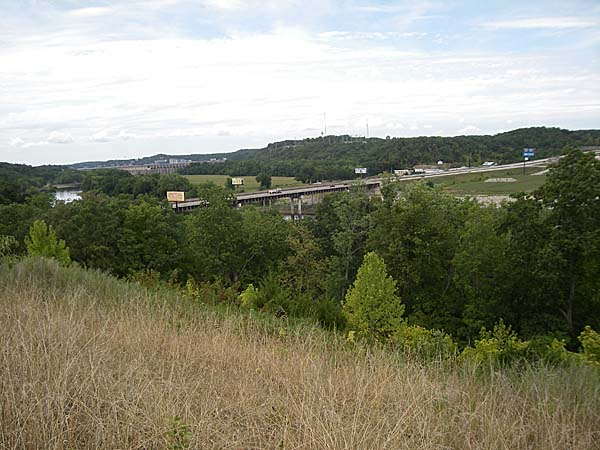
02 Highway 54 Bridge Bypass
Members of the Miller County Albertson family came to the museum recently to donate a couple of family heirlooms. One of the heirlooms was a hand made furniture table made by David Albertson sometime between 1870 and 1880. It was used in his first home. His son, Ira Albertson handed it down to his descendents who are now donating it to our museum.
Here is a photo of the members of the Albertson family who brought the table to us standing behind the antique table (photo 03):
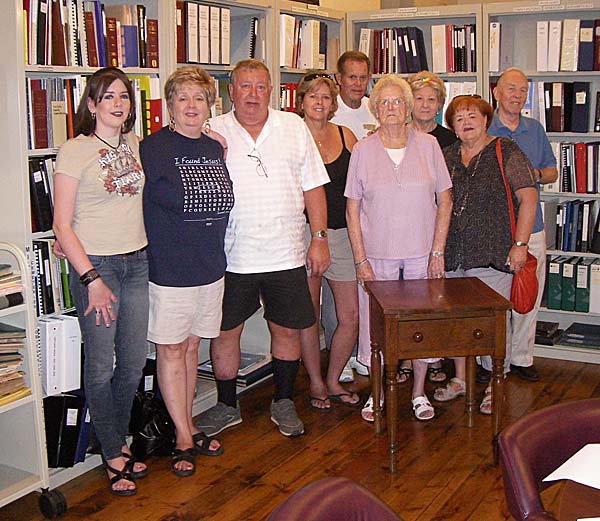
03 Albertson Family with Side Table made by David Albertson 1821-1860 The following are the names of those behind the table reading left to right are:
Kimberly Owens, Brenda Hundley, William Dawson, Mizi Albertson Beard, Wanda Jenkins Albertson, Jeanine Albertson McIntosh
Back three: Kenneth Goosey, Virginia Goosey, Tom Albertson
In addition to the table, Virginia Sue Anderson Goosey, granddaughter of Ira Jasper Albertson and Susan Eulalia Albertson, brought to us for donation a small lead smelter (photo 04).
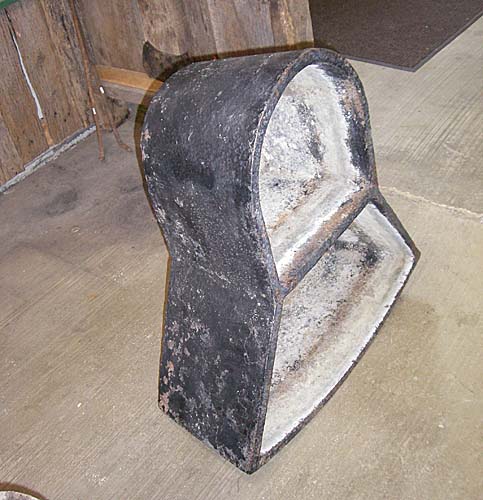
04 Lead Smelter Pot made by Ira Albertson Virginia donated the smelter in honor of her mother, Olive Cora Albertson Anderson and her grandparents, Ira Jasper Albertson and Susan Eulalia Roberts Anderson. The smeltering pot came from Ira and Susan’s Albertson’s property where lead was mined in the early 1900’s. Their farm was at the location of the small town of Gageville, now no longer present, but which was very active in the late 1800’s and early 1900’s when lead mining was an important enterprise in Miller County, especially at Gageville. Virginia says the Gageville cemetery is all that remains of the settlement of Gageville, and it is located just a short distance from a gate which leads to the original Albertson farm (photo 05).
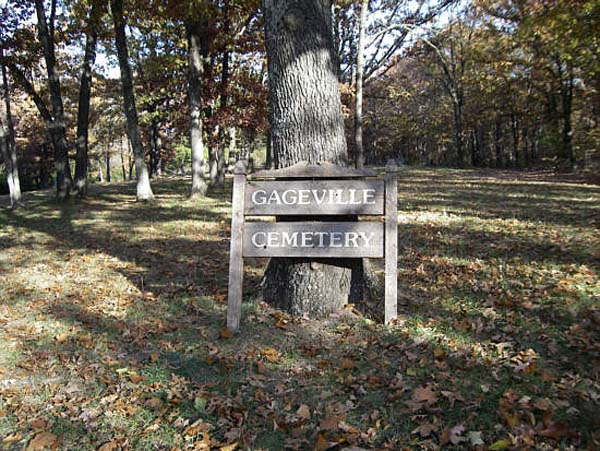
05 Gageville Cemetery Virginia says she and her mother both were born on this farm. In the late 1800’s the farm was owned by Levi Albertson, brother to Ira Albertson.
In addition to the smelter and the table, the Albertson family also gave me a couple of descendency charts of the Albertson family which you can read in this attachment in PDF format (photos 06 - 12):

06-12 Descendants of Early Albertson
Click image to view entire document in PDF formatWanda Albertson, and her husband, Jim Albertson (now deceased) established an ongoing fund for the maintenance of the Gageville Cemetery. You can read more about that as well as Gageville at this previous Progress Notes:
Another previous Progress Notes presents the history of Gageville and the Gageville mines.
The St. Elizabeth MFA Exchange celebrated its 90th year in operation recently as reported by the Autogram Newspaper. The story was of interest to me since the first manager of the Exchange, Irvin Curry, was married to my great Aunt, Barcy Abbett, my grandmother’s sister. Here is a photo of Aunt Barcy and Irvin and Barcy’s sister, Sadie, my grandmother, at their farm taken sometime in the 1930’s (photo 13).
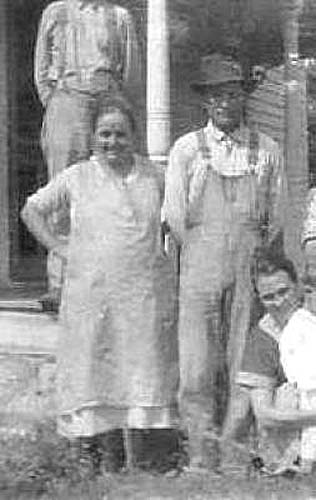
13 Barcy and Irvin Curry, Sadie Abbett, sister of Barcy Kneeling And here is the recent newspaper story as copied from the Autogram presenting the story’s photos first:
Miller County Autogram Sentinel
July 19, 2012
Co-op celebrates 90 years of service business
(photos 14, 15 and 16)
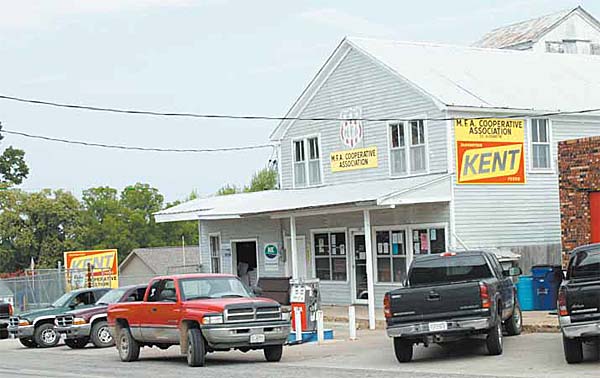
14 St. Elizabeth MFA Co-Op - Autogram Sentinel
The Co-Op has been located at the same site since 1922 although the building
has been added on to several times.
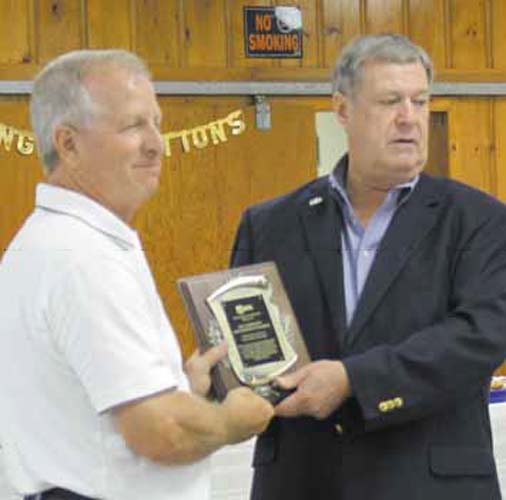
15 90 Years of Service to Community - Autogram Sentinel
MFA President Bill Streeter, right, presented a plaque to
local co-op manager
Rich Juergensmeyer.
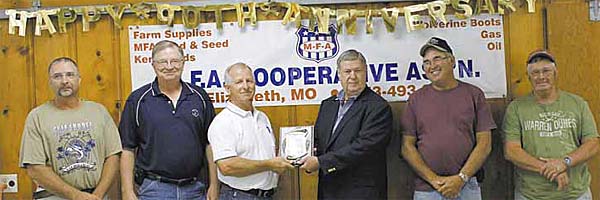
16 Anniversary Plaque - Autogram Sentinel
Showing off the 90th anniversary plaque for the St. Elizabeth MFA Cooperative at center are
manager Richard Juergensmeyer, third from left, and MFA President Bill Streeter.
Others in the photo are the local board members. They are, from left, Joe Schanzmeyer and
Frank Bax, far left, and Paul Bax and Leonard Holtmeyer, far right. St. Elizabeth’s MFA Exchange is in the same building it moved into in 1922 when the cooperative was founded. On Saturday the co-op celebrated the 90th anniversary of its
founding on July 12, 1922. MFA President Bill Streeter talked about the cooperative and the oldest ones in the state before presenting a plaque for the 90th anniversary. A meal also was served and door prizes given away at the celebration, which was held in the St. Elizabeth Community Center.
Streeter said MFA is the oldest farm marketing cooperative in the U.S., founded in 1914. There were such co-ops before but none of them survived. MFA also formed an oil
cooperative, a propane cooperative, which is among the largest in the nation, and an insurance company, now known as Shelter Insurance.
The statewide cooperative also had an artificial insemination service from the 1940s until sometime in the 1950s, Streeter said. Farmers ordered the semen from the bull of their choice. On the day it was to be delivered they were to spread a sheet in a field. A plane flew over and the container of semen was dropped by parachute. Streeter said they probably never hit the sheet but got close enough that the container could be found. It was up to the farmer to have a technician or veterinarian lined up to inseminate the cows. “These were all started by farmers,” Streeter said. “Missouri and Missouri farmers have a lot to be proud of.”
Current St. Elizabeth MFA manager Richard Juergensmeyer said the building has been added on to over the years but the co-op has always been at the same site. The group also owned the Schell Building across the street and on the corner of Highway 52 (Walnut) and Main streets for a time, operating a grocery store. However, the co-op has not been in the grocery business for decades.
Ray Doerhoff, who had a band with his brothers, said a dance hall used to be on the second floor of the building. Juergensmeyer said the old records for the cooperative are up there now but he has not gone through them.
The co-op has had only five managers in its history. The first was Irvin Curry. Emil Lindenbusch followed him, working for the cooperative for 35 years. Dennis Heckemeyer and George Holtmeyer were the next two managers and Juergensmeyer is the fifth. Holtmeyer, who attended the celebration, said the co-op used to be open seven days a week. “Sunday was our biggest day,” he said. That is because many women only came to town on Sunday, for church, and did their shopping afterwards. Many times what they bought was delivered on routes the co-op ran three times a week.
Holtmeyer got many laughs when he was talking about feed and flour sacks that had print patterns on them and were used to make clothing after they were emptied. It was common for a woman to come in and want a particular pattern. If it was Sunday, he would have to go find the right pattern, while wearing his Sunday suit. It was also common for him to come up with the wrong pattern the first time and have to go back and find the right one, he said.
Mary Ann Lindenbusch, wife of the late Emil Lindenbusch, said at one time, the coop did $1 million in grocery business each year. Holtmeyer said the cooperative used to buy eggs, milk and other produce and farm products brought in by its members, the “exchange” portion of the St. Elizabeth’s MFA Co-op has been located at the same site since 1922 although the building has been added on to several times. He said he remembers there was a cream separator in the store. The local cooperative truck went to Springfield every day, and sometimes twice, to pick
up feed, hardware and groceries, Holtmeyer said.
There also used to be a Women’s Progressive Farmers Association (WPFA) associated with the cooperative, and Junior Farmers Association. Mrs. Lindenbusch said the
WPFA, which was founded Nov. 20, 1936, no longer exists but the membership formed the current quilting club. She said she also remembers riding in the MFA truck to Springfield with JFA members who were showing livestock at the Ozark Empire Fair.
Accompanying Streeter to St. Elizabeth Saturday was Joanie Ortbals Egbert, a St. Elizabeth native who started her long career with MFA at the St. Elizabeth store. She
later became a field auditor for the statewide group. Now retired, she said she started her career in 1967.
About 100 people attended the celebration. The door prize awards were as follows:
Prizes donated by Orgill, Inc. were Ella Lucas—a battery charger; Victor Wilde—a 100-foot garden hose; Ronald Schubert—a trouble light; Shirley Kemna—a faucet kit.
Prizes donated by St. Elizabeth MFA Cooperative were Patricia Struemph—a push broom; Lucy Lucas—a fire extinguisher; Lane Irvin— leather gloves; Cannon Schanzmeyer—knife sharpener; and Dianne Holtmeyer, MFA dog food.
MFA Oil donated the following prizes. Winners were Greg Rehagen, anti freeze; and Brent Irwin, bar and chain oil. Bernice Holtmeyer won a booster cable donated by Forney INC.
The following is a short narrative written by St. Elizabeth native Robert Oligschlaeger of his memories of Irvin Curry, the first manager of the Exchange:
Robert Urban Oligschlaeger (photo 17)
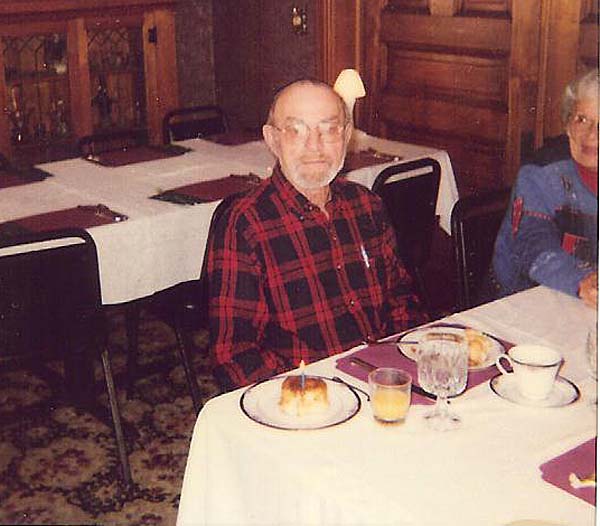
17 Robert Urban Oligschlaeger We had a Model T Ford, a 1926 model. We bought the car new at a little over $500. I don’t remember when they bought it because I was only two years old but I do remember riding in it. Then the Depression came along and we couldn’t buy gasoline for it. We also couldn’t afford to license it so it sat in the corn crib next to the barn. Finally, we sold it for $10 to Irvin Curry. He fixed it up and it ran for a long time. He was the manager of the Exchange there in town. He drove it between work and Capps for a number of years. I wish I had it now. I remember riding in it. It was a touring car with curtains in it. I remember going to Meta in the car. We went every fall to buy apples at the Exchange in Meta. They didn’t come in baskets or we couldn’t take the baskets with us so we poured them into the back seat of the car and filled it up till it was full. Then we brought them home like that. I remember seeing the back full of apples several years.
Before the MFA was built in St. Elizabeth, we did a lot of trading in Meta at the MFA. The prices were better because Shell’s store was very expensive. They were buying railroad ties and were at one time the biggest tie dealers in the area. The store bought ties locally, hauled them to Meta to the railroad yard. They also floated ties down the Osage River. They were really green wood and very heavy. I remember many a tie load going by the house when I was a young boy. I think 10 or 12 would be a load that was heavy enough for a team to pull over the steep hills to Meta.
The following I wrote a few months ago about Barcy, wife of Irvin:
Barcy loved to cook. In fact, she had three kitchens. Her first kitchen had her first stove, which was heated by wood. When propane gas became available in individual tanks, she added on a small extra room and bought a gas stove, keeping the wood stove. Then in the 1950’s when electricity arrived to the area she bought an electric range and built on a small addition to the house for her third stove. Barcy used all three stoves at times as she was used to preparing large meals. Barcy also harvested game off the farm to supplement her meals. In fact, she kept a loaded Winchester 30-30 lever action rifle by the kitchen door in case a deer happened to be walking across the nearby field.
As you can judge by the photo of my Aunt Barcy above, she certainly enjoyed her own cooking!
One thing always holds true about St. Elizabeth: about everyone there knows how to cook. Last Sunday, July 22 Judy and I accompanied her brother Don Steen and his wife Alisa to the annual St. Elizabeth picnic. The huge dining area was filled with visitors eager to enjoy the German influenced culinary skills of the very friendly folks who live there (photo 18).
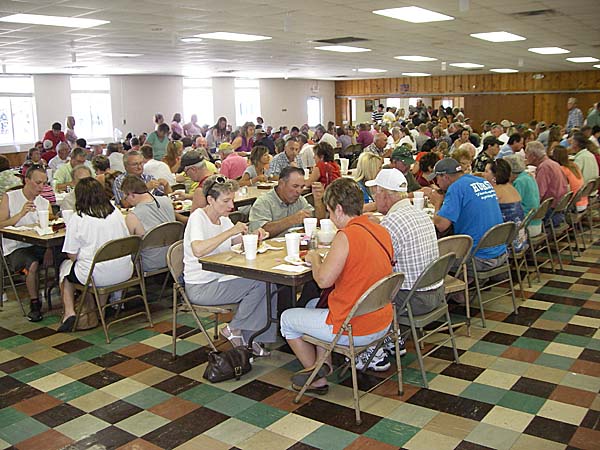
18 St. Ellizabeth Picnic Dinner Here is a photo from the Autogram of a quilt which was raffled that day (photo 19):

19 Quilt to be Auctioned Another local event we attended that week was the Brumley Bean Supper, which is held the third Saturday monthly. A large crowd was present as usual (photo 20).
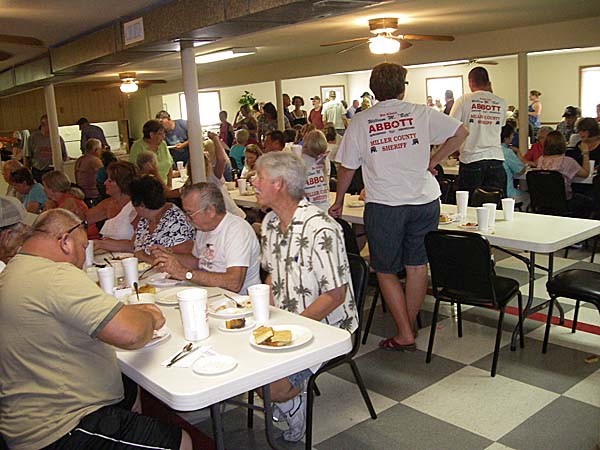
20 Brumley Bean Supper The drought continues with temperatures above 100 degrees daily. Pastures are brown and no grass can be found. One cow on my mother in law Elva Steen’s farm was a little smarter than some, it found a way to open the barn door and get into some hay left over from winter (photo 21).
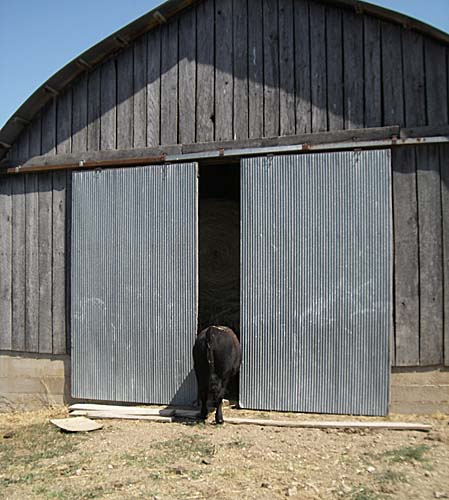
21 Hungry Cow
That’s all for this week.
 Joe Pryor
Previous article links are in a dropdown menu at the top of all of the pages.
|

